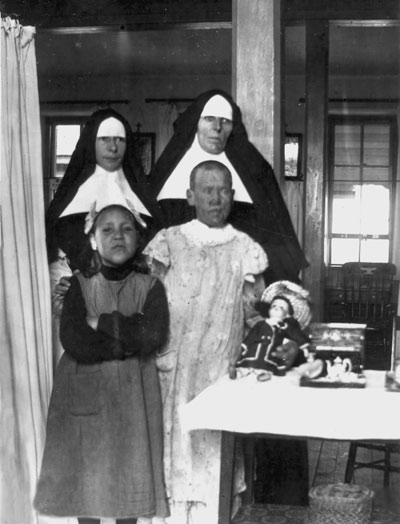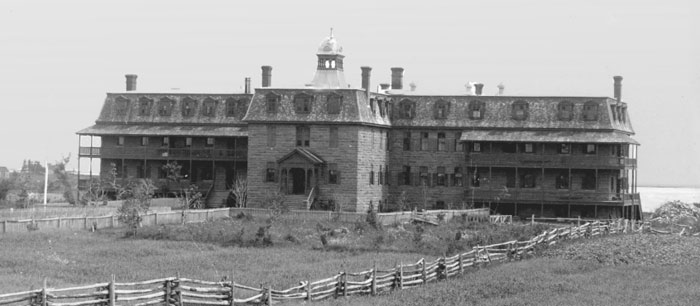 The arrival of the Hospitalières at the lazaret transformed little by little this disgusting place into a structured hospital. They first had to clean up the place by scrubbing the building from top to bottom. Then, they reorganized the rooms, set up a pharmacy, a small clinic, and lodged the women on the second floor while the men occupied the first floor and where the chapel was also located.
The arrival of the Hospitalières at the lazaret transformed little by little this disgusting place into a structured hospital. They first had to clean up the place by scrubbing the building from top to bottom. Then, they reorganized the rooms, set up a pharmacy, a small clinic, and lodged the women on the second floor while the men occupied the first floor and where the chapel was also located.
Finally, in 1880, the lazaret became an institution of the federal government and the nuns were entrusted with its entire administrative responsibility. Improvements were made to the existing buildings and a wooden annex was built in 1881 to house a new pharmacy, a procuracy for the lazaret, a supply store and a kitchen for the lepers. Sister St-Jean-de-Goto, who was called doctor, and who later became the mother superior, took care of the pharmacy and prepared the medications. During her first months at the lazaret, she treated from this small clinic more than 1700 persons from the surrounding area. In a letter written in 1887, a novice wrote: « Although the rooms for the sick were kept very clean, one could not avoid …breathing the odor of fever and the suppurating wounds… Disinfectant was a rare commodity… The lepers’ wounds were very sensitive; some of them had bloodied fingers. »
 In 1893, the federal government granted credits for the construction of a stone lazaret that would be completed in 1896. The lepers who were admitted on April 8, 1896, thought they were in paradise. During the last thirty years of the existence of the lazaret, the number of patient dropped considerably. During the ten-year period of 1934-1944, there were only five admissions.
In 1893, the federal government granted credits for the construction of a stone lazaret that would be completed in 1896. The lepers who were admitted on April 8, 1896, thought they were in paradise. During the last thirty years of the existence of the lazaret, the number of patient dropped considerably. During the ten-year period of 1934-1944, there were only five admissions.
In January1943, the general hospital and the lazaret were completely destroyed when a fire started in the morning in the electrical system. The superintendent’s residence, inhabited then by the Ryan family, served to lodge the eight patients of the lazaret. The nuns set up a temporary hospital in the orphanage portion of the Academy that served as a boarding school; the orphanage was closed.
When the new hospital opened its doors in 1946, twelve rooms, including a kitchen, a sitting room and an office, were reserved for the lepers. According to statistics, from 1849 to 1965, two hundred and eighteen (218) patients were treated at the leprosy hospital in Tracadie.

